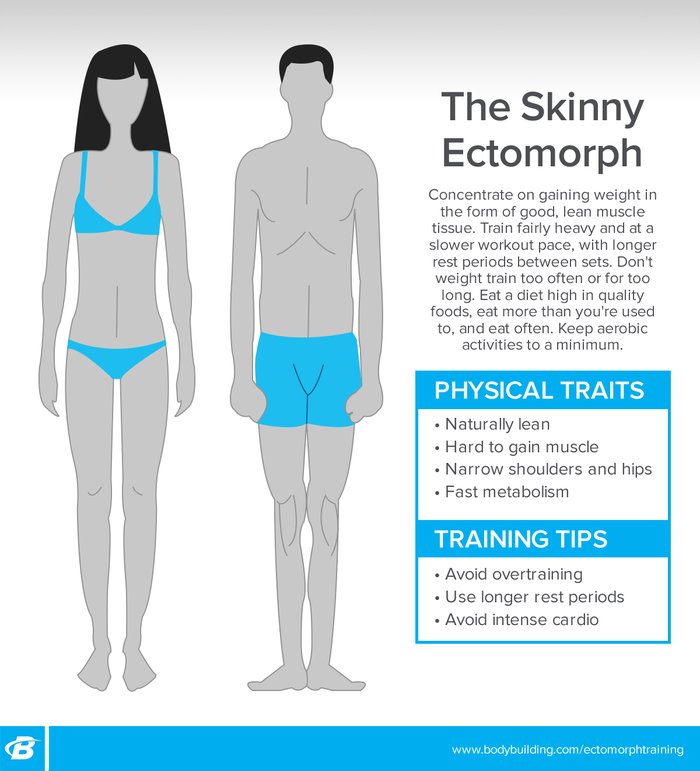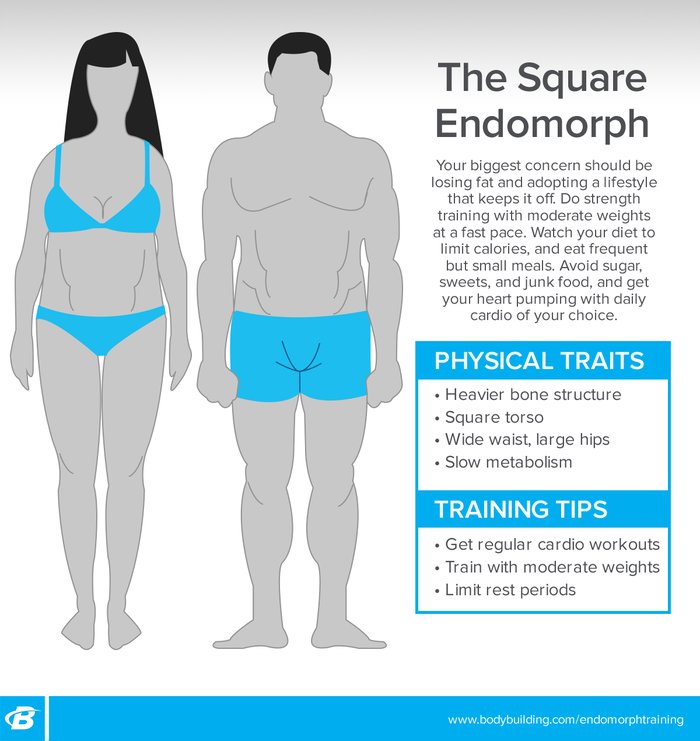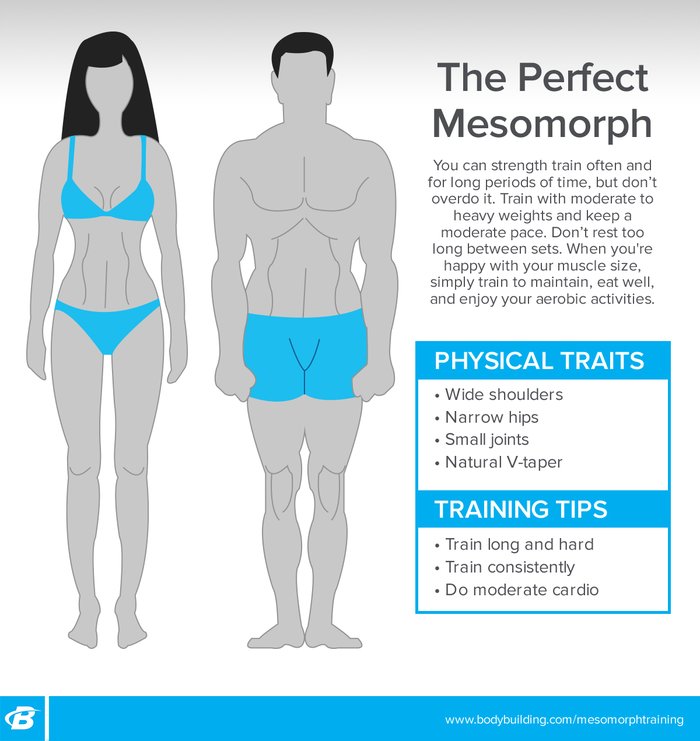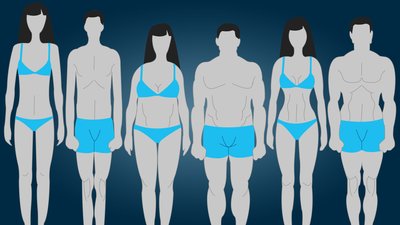We all have different body types and tendencies. Some of us are naturally skinny and struggle to put on weight without a heaping mass-gainer shake once a day. Some are naturally heavy and add muscle easily, but struggle to shed body weight and find ourselves reaching for a fat-burner every summer. Our bone structure and muscle belly length differ, too, meaning we'll be best served by different types of workouts to help us reach our goals.
If you're in the dark, this body type quiz can help you determine where you stand on the spectrum. Here's what lifter and athlete needs to know about body types, and how to customize their workouts for their personal body.
No matter what your body type is, you can optimize it by eating adequate protein to go along with your training. A post-workout protein shake can help you get there!
The Skinny Ectomorph
You know those people who seem to be able to eat all they want whenever they want and never gain an ounce? Those people are probably ectomorphs.
They're often naturally lean, which is a great upside. The downside, especially if they are trying to improve their physiques, is that they have a hard time gaining muscle mass.

Some people think that all ectomorphs are tall and skinny. Many tall people do happen to be ectomorphs, but height alone isn't a determining factor. Rather, body type is based on factors that include skeletal proportions, bone density, and metabolism. For instance, ectomorphs tend to have narrow shoulders and hips, light bones, and fast metabolisms. Their wrists, knees, and ankles are typically smaller than average.
Creatine monohydrate has repeatedly been shown to help increase both muscle size and strength. If you're an ectomorph trying to gain weight, 5 g per day is a no-brainer.
The Square Endomorph
Endomorphs tend to have heavier bone structures and less-tapered torsos, with wide waists and large hips. Their joints are often thicker, and their metabolisms are slower.

Unlike ectomorphs, endomorphs have no problem adding mass to their bodies. Their problem is getting rid of it. If people with this body type want to get lean, they must be very diligent about eating well and getting adequate cardiovascular exercise to go along with their lifting workouts.
Branched-chain amino acids are a low-calorie, workout-boosting alternative to soda and sports drinks. If you're an endomorph struggling to lean out, try drinking BCAAs throughout the day!
The Aesthetic Mesomorph
Oh, to be blessed with a mesomorphic body type. Many of the greatest bodybuilders in history, including Sergio Oliva, Lee Haney, Dorian Yates, and Ronnie Coleman, are perfect examples of this lucky group. Their bone structures, with wide clavicles and narrow hips, naturally form the coveted V-taper. Their joints are big enough to support large muscle mass, but small enough to create a pleasing visual proportion between muscle mass and joint.

If you took Coleman's huge quads and put them on a man with big hips and knees, they wouldn't look nearly as impressive. But with Coleman's narrow hips and small knee joints, those quads look superhuman. And then there's the mesomorphic metabolism: It is ideal, making this body type genetically predisposed to gain muscle, not fat.
A high-quality pre-workout can help mesomorph lifters bring intensity and power to their workouts. Make the most of every set and rep to maximize your results!
Train for Your Body Type
Chances are you're not 100 percent ectomorph, endomorph, or mesomorph. Instead, you probably fall somewhere along the spectrum. You might lean more toward being an ectomorph, yet be able to add muscle mass, making you an ectomorph with some mesomorph qualities. Or, you might have the basic body shape typical of a mesomorph, but gain fat if you're not careful, which would put you somewhere between a mesomorph and an endomorph.
Having said that, you're probably closer to one body type than another. Once you know which type that is, you can start creating the most appropriate training program for that body type.
Ectomorph Training
Ectomorphs tend to have higher metabolic rates, with their bodies acting like crazy calorie-burning furnaces. If this is you, be careful not to over train, and make sure you allow plenty of time for rest and recovery. It you tried to train for two hours a day, six days a week, you're probably doing too much and need to build more rest days into your routine. In fact, ectomorphs should probably not weight train more than two days in a row. Many find that something like Monday, Tuesday, Thursday, and Friday is ideal.
Your workouts should be short and to the point, rather than marathon sessions. Put a time limit of one-hour maximum on any given workout. Focus on basic, compound movements and straight sets in the 8-10 rep range. Forget about higher reps, dropsets, and supersets, and other intensity techniques that will only make it harder for you to recover before your next workout. Limit any extracurricular physical activity, and rest as much as possible.
Finally, if you're an ectomorph and want to improve your physique, avoid frequent bouts of prolonged cardio, which can tear down muscle tissue. If you feel compelled to do cardio, limit yourself to just a few minutes to warm up on leg day. Focus your attention on conserving energy so you can add, not subtract, muscle mass.
Endomorph Training
Because they have slower metabolisms, endomorph usually benefit from greater overall training volume and frequency, and from doing substantially more cardio than the other two body types.
When endomorphs focus on lifting heavy, they tend to gain more fat. If you're okay with that, then train more like a powerlifter, with lower reps and plenty of rest between sets. But if you'd rather carry less body fat, keep your rest periods shorter and move quickly from exercise to exercise and from set to set. This faster pace will burn more calories, as will judicious use of supersets, dropsets, and so on. There is no need to go crazy with higher reps, but try to work in the 10-12 range for upper body, and do 12-20 reps for lower-body movements.
Endomorphs can and should also perform an even mix of compound and isolation movements. Squats and deadlifts will do far more to stimulate your metabolism and burn calories than things like leg extensions or cable cross-overs. And if you tend toward the endomorph end of the spectrum, you'll get the best results, in terms of body composition, by skipping rest days. On days that you're not weight training, go to the gym or get outside and work hard on your cardio.
Mesomorph Training
If you hit the genetic lottery and are anything close to a pure mesomorph, whatever kinds of hard and consistent training you do will probably yield spectacular results. You can train longer and hit muscle groups more frequently that the other two body types, and make major gains. In fact, you'd probably be missing out if you didn't work harder.
As a mesomorph or near-mesomorph, your workouts can be a bit longer, in the 60-90-minute range, and can be a mix of compound and isolation movements, with reps as low as the 4-6 range or as high as 15-20. Either way, you're golden.
In general, mesomorphs can pretty much emulate the routines of pro bodybuilders and make very nice progress, because you're essentially like them. Although it should be noted that if you are chemical-free, train with a bit less volume and frequency than a chemically-enhanced athlete, since products designed to help build muscle mass can also aid recovery. As far as cardio goes, you don't need to avoid it like ectomorphs or hit it hard and heavy like endomorphs, a moderate amount will do you just fine.



